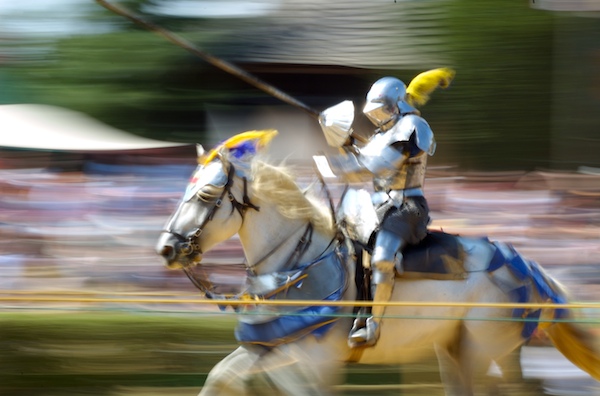Here at Dear Sports Fan we tend to have inclusive opinions about sports. Oh, sure, I like getting into bar arguments about whether baseball or soccer or darts or pool or car racing or boxing or log rolling is really a sport as much as the next guy, but at the end of the discussion, if any of those things are being shown on TV, I’ll happily watch it. As long as something is competitive and requires some combination of physical and mental expertise, I think it’s a sport. Recently two strange sporting events came to my attention. The first requires total precision and complete focus in the midst of a high speed world. The second requires total relaxation and complete inattention in the midst of a high speed world. It’s hard to say which is a more more impressive feat. The first is a modern form of the Middle Ages sport of jousting. The second? An innovative “spacing out” tournament held in Seoul, South Korea.
Most of us have a general understanding of jousting from movies or books. Two heavily armored knights charge at each other on horses with long wooden spears called lances and the winner knocks the loser off his horse. Jousting emerged as a sport in the 1300s out of fairly disreputable duels fought between people on horseback. These pre-sport jousts often began with two or more combatants on horses with lances but would continue with hand-held weapons once the fighters were close enough to make lances unwieldy. As the principles of chivalry swept through the upper classes of Northern Europe, jousting transformed into a generally non-lethal competition. Throughout the Renaissance, the joust became increasingly specialized and distant from actual fighting. A barrier was put in to separate the two competitors and specialized jousting armor was created which could weigh up to a hundred pounds. Jousting as a popular form of sport came to its end at the very tail end of the 1500s when King Henry II of France was killed in a jousting accident.
Luckily for us, that’s not the end of jousting’s story. Jousting is still done today, it just looks a little different. Since 1821, the Natural Chimneys Joust has been held in Mount Solon, Virginia. This makes it one of our country’s oldest continuously running sporting events. Older even, members of the jousting community contend, than that other horse related competition, the Kentucky Derby. Modern (if you can call it that) jousting, is competitive but not confrontational. Competitors take turns running their horses down an 80-yard path and, at full speed, catch small rings on the end of their lances. This sounds reasonably tame until you see how small the rings are: one inch in diameter for the best jousters. Each jouster gets three runs down the course and the one who catches the most rings after three attempts win. If there is a tie after the three runs, the remaining jousters move to single elimination runs, like a soccer shootout after the first five shots. During these ride-offs, the rings get progressively smaller. To break particularly insistent ties, rings the size of life-saver candies can be used.
The jousting community is tight-knight and multi-generational. Andrew Jenner‘s descriptions of “Zula Casady, the 91-year-old matriarch of the Natural Chimneys Joust” and her family were my favorite parts of his article The Fading Glory of America’s (Allegedly) Oldest Sporting Event in Modern Farmer. This article is what led me down the path of jousting discovery and I’m sure you’ll enjoy reading it too.
From rural to urban and from Virginia to South Korea we go for our next strange sport: spacing out. That’s right, there was a tournament held in Seoul, South Korea recently that crowned a nine-year old as its champion. The various athletes who decided to enter the competition had to sit or lie or sprawl for three hours with no access to smart phones or other technology. According to Brian Ashcraft of Kotaku, organizers would “go around and check people’s heart rate or try to make them laugh to see who, in fact, was truly spaced out.” Jeanne Kim, writing for Quartz, relayed a statement from one of the organizers of the tournament: “Because of smart devices, we are unable to escape from external stimulation even for a moment. In such a society, I wanted to contemplate the idea of not doing anything.”
I don’t know about you, but I think this sport is a great idea. I’d love to participate! Watching it… now that’s another story. I doubt it would make for a very good spectator sport, although this one minute youtube clip is delightful. Enjoy!

